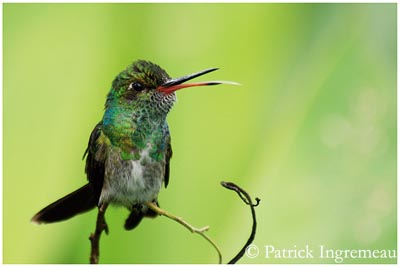
Fr: Ariane de Linné
All : Glitzeramazilie
Esp : Diamante de Cabeza Parda
Ital : Amazilia gola scintillante
Nd : Franje-amazilia
Photographs by Patrick Ingremeau
TAMANDUA
Text by Nicole Bouglouan
Sources:
HANDBOOK OF THE BIRDS OF THE WORLD Vol 5 by Josep del Hoyo-Andrew Elliott-Jordi Sargatal - Lynx Edicions - ISBN: 8487334253
A GUIDE TO THE BIRDS OF COLOMBIA by Steven L. Hilty and William L. Brown
Princeton University Press – ISBN 069108372X
Arthur Grosset's Birds (Arthur Grosset)
Glittering-throated Emerald
Amazilla fimbriata
Apodiforme Order - Trochilidae Family
BIOMETRICS:
Length: 8-12 cm
Weight: 4-6 g
DESCRIPTION:
Glittering-throated Emerald adult male has bronze green to golden upperparts. Tail shows two central bronze-green feathers, becoming darker towards the external blue-black rectrices. On the wings, flight feathers are blackish-bronze.
On the underparts, throat and breast show glittering golden-green feathers. Centre of lower breast and belly are white, while the sides are bronze-green. Vent and under tail coverts are white with brownish centres. Tail is blackish-bronze.
Head is glossy bronze-green. Medium-sized, straight bill shows blackish upper mandible. Lower mandible is pinkish, with dusky tip. Eyes are dark brown, with a small white patch behind the eye. Legs and feet are blackish.

Adult female is almost similar, but she has white bars on throat feathers, and the most external rectrices have greenish-grey tips.
Immature has more greyish-brown on belly than white colour.
We find seven subspecies showing some physical differences in colours, and living in different regions in South America, mainly in Brazil.
VOICE: SOUNDS BY XENO-CANTO
Glittering-throated Emerald utters soft “dz-dz”, as pebbles striking together. When in flight, it gives a loud “peep-peep” rising and descending. Male gives squeaky, high-pitched advertising songs.
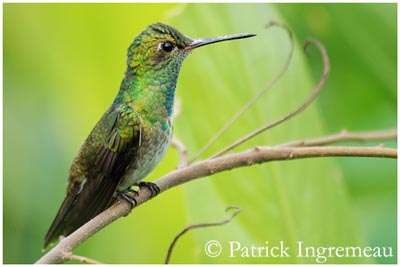
HABITAT:
Glittering-throated Emerald is common in open and semi-open areas, but it avoids dense forest. This species frequents several kinds of habitats such as shrubby second growth, gallery forest edges, dry and wet forests, savannahs, cultivated areas with bushes and trees, plantations and gardens.
It also can be found in mangroves in Atlantic coast. It can live from sea-level to 1000 metres of elevation, but mainly below 500 metres.
RANGE:
Glittering-throated Emerald lives in The Guianas and Venezuela, to south Bolivia and south Brazil.
BEHAVIOUR:
Glittering-throated Emerald is usually seen singly, but often near habitations. It forages at low to medium height in shrubs and second growths. It often perches in open.
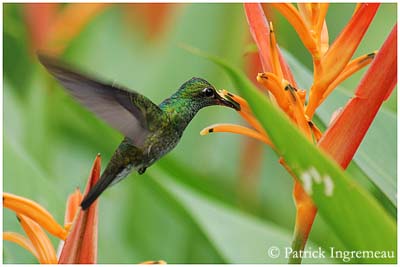
It feeds low in flowering trees, but takes nectar while perched too. It feeds on nectar from large variety of native or introduced species, at flowering herbs and bushes, and in trees. It can hunt for insects such as small flies and beetles.
The feeding area is often defended by the male. It perches on nearby exposed branches and when a predator or intruder is detected, it utters vocal warning signals, and performs agonistic flights. But sometimes, the feeding territory is too scattered to be well defended.
Female may exhibit threat behaviour against predators and intruders approaching the nest-site, by performing fly-attacks.
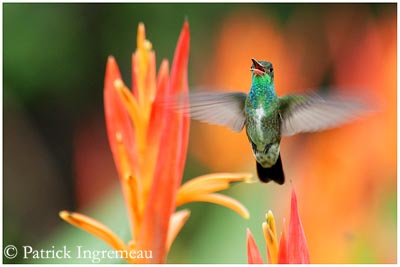
FLIGHT:
Glittering-throated Emerald hovers in order to feed on nectar. Apparently motionless, its wing-tips perform very rapid figures-of-eight. During this flight, the hummingbird can perform 10 to 80 wing-beats per second, but during displays, about up to 200 wing-beats per second can be performed!
It is able to perform aerobatics for reaching hidden food reserve. It can fly in all directions, including backwards for leaving a flower.
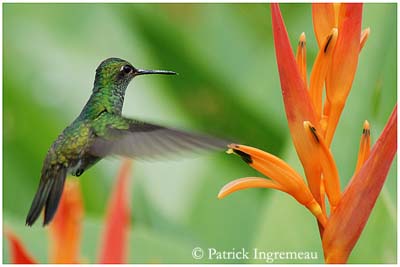
REPRODUCTION:
Glittering-throated Emerald breeds almost year round.
Female usually selects the nest-site and builds the nest. Nest is often situated on horizontal branch. It is cup-shaped, made with plant wool, cobwebs, fine strands of dry vegetation and lichens, at about 4 metres above the ground, sometimes lower, rarely higher. Nest needs 6 to 12 days to be built.
Female lays two eggs. Incubation lasts about 14 to 17 days, by female. Chicks are covered with buff down on the back. They fledge at about 18 to 22 days of age.
This species produces two broods per year, sometimes more.
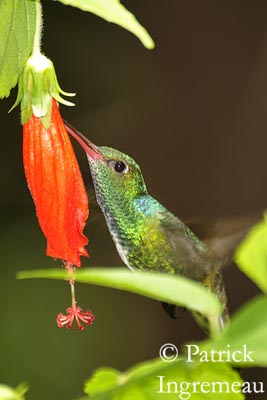
DIET:
Glittering-throated Emerald feeds mainly on nectar of flowers, from large variety of native and introduced species. It also consumes small flies and beetles.
PROTECTION / THREATS / STATUS:
Glittering-throated Emerald is common to very common in most parts of its range, mainly in northern and eastern parts.
This species has probably suffered from deforestation of coastal areas where it is uncommon.